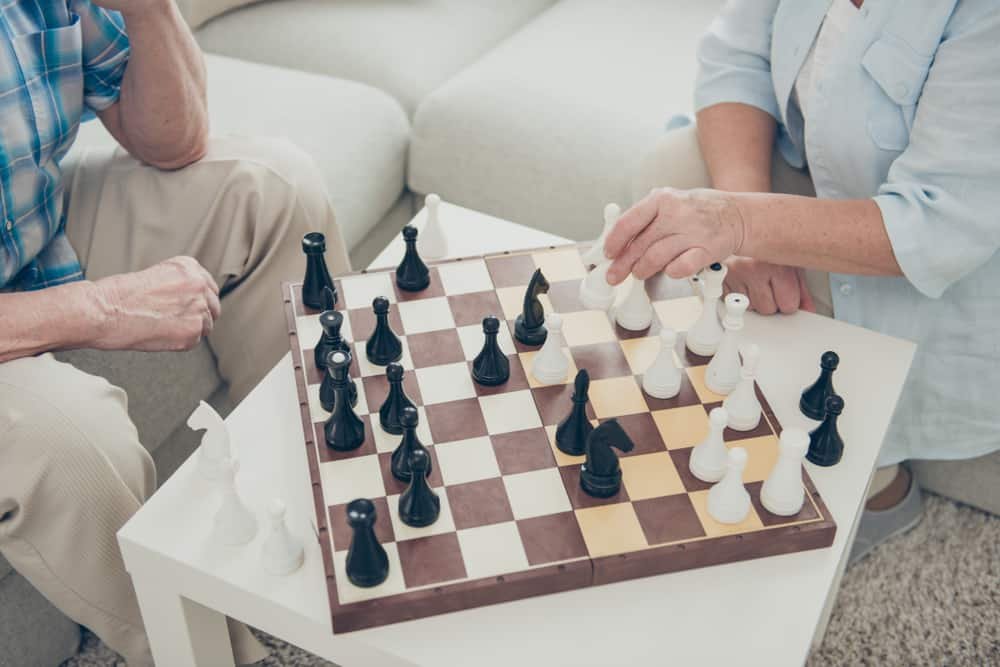Last Updated on January 7, 2024 by Gamesver Team and JC Franco

To become a chess master, you need to read about it, study it, and practice it often. It has been said that 99% of the game is strategy and tactics!
If you’re reading this, you may be wondering to yourself, ‘are there any tips I should know about in order to improve my chess skills?’. There are many things all beginning chess players should know in advance. These include various ways to study, practice, and (ultimately) win the game.
So, if you’re ready to learn the tips and tricks to improve your chess game and increase your chances of winning, then let’s get started?
These are 21 must-know chess tips for beginners.
1. Learn How Each Piece Moves.
Ok! For some, this might be completely obvious. However, if you’re a complete beginner, and don’t know much about chess, it’s essential that you learn and have a clear idea of how each piece moves.
Each piece can only move a certain way. Let’s take a look at each one separately.
- The PAWN moves forward, one square at the time. There are two exceptions to this rule: (1) only on the first move of the game, a pawn can move two squares forward; (2) to capture an opponent’s piece, a pawn has to move one square diagonally.
- The KNIGHT moves in an L-shape.
- The BISHOP moves at an angle, as many squares as available.
- The ROOK or CASTLE can move in a straight line only, going forward, back or to the side.
- The QUEEN is the most powerful piece and can move in any direction for any number of squares. However, this piece cannot move in multiple directions in a single turn.
- The KING advances one square at a time in all directions.

2. Not All Pieces are Created Equal.
You must determine which pieces you can and cannot afford to lose. For example, in most situations, you don’t want to lose a knight to save a pawn. Use the following point system to determine which ‘swap’ is a good one.
- Queen = 9 points
- Rook = 5 points
- Bishop = 3 points
- Knight = 3 points
- Pawn = 1 point
However, keep in mind that in certain situations and depending on your strategy, it might make sense to “sacrifice” or swap a more valuable piece for a less valuable one.
3. Move Two Squares to Begin.
As mentioned before, the pawn can move two squares forward on the first move of the game. Therefore, begin by moving one pawn (in front of the king or queen) two squares forward. This allows your bishop and queen to enter the game. Because bishops move at an angle, they need openings in order to invade the battlefield.

4. Continue with the Knights and Bishops.
Getting the knights and bishops out from behind other pawns and into the center of the board so they can attack and protect, is vital. Therefore, you need to move them first, with the exception of the pawns.
5. Stay on Track.
Do not waste time by trying to make too many moves with your pawns. Try not to get caught up in picking off your opponent’s pawns but rather focusing on the plan at hand.
6. Enter the Rook!
Moving your king to safety and bringing your rook into play is known as ‘castling’. You want to do this early on in the game so that if your opponent forgets, you can launch an attack on his king. This is done by moving the king two squares closer to the rook while the rook moves to the square on the opposite side of the king.
*Note that this is the only time when more than one piece can be moved in a single turn.

7. Establish Your Pieces.
It is easy to get caught up in the strategy of focusing too much on just a few specific pieces. Try to use your full arsenal of pieces when playing. You have them for a reason. Move them off of their first position and get them participating in the fight!
8. Maintain the Center
The best area to gain control of early on is the four squares in the middle. This is the ‘gateway’ to the rest of the board and allows you to move your pieces anywhere you want.
9. The ‘Middlegame’ Attack Plan.
Once your pawns, knights, bishops and rooks have been brought into play, you have entered what is known as the ‘middlegame’. At this point, you should be looking for ways to capture your opponent’s pieces, without compromising your position.
10. Advance the Pawns for Promotion.
After most pieces have been swapped and you and your opponent are down to only a few remaining men each, the ‘endgame’ is at hand. Each pawn is crucial now. If you can move any pawn to the farthest row away from you, that pawn can potentially become a queen (promotion), which gives you a huge advantage!

11. Use Your King to Attack in the ‘Endgame’
In the ‘endgame’, allow your king to attack whenever possible, as long as he remains out of reach from your opponent’s final pieces, especially the queen!
12. Be Strategic!
Before each turn, re-evaluate what your opponent’s last move was and try to determine his/her motivation. Is he/she laying traps for your capture? What is he/she planning? What possible outcome could this move have on the game? After answering these questions, decide on your method of action, reviewing each move before you play it and try to outline the possibilities resulting from them.
13. Be Patient.
Patient thinking is the key to winning at chess. If you see a good move, wait, and look for an even better one. Take your time and stay focused.
14. Develop Your Visualization Skills.
Being able to see imaginary positions in your mind without moving any actual pieces on the board is a skill that will give you a definite advantage over your opponent, especially if he or she can’t do it!

15. Recognize Your Style.
You may favor one strategy over another when it comes to chess. Perhaps you feel most comfortable when defending your pieces. Or, maybe you have an instinct for attacking. Whatever it is, play towards your strengths and work to improve your weaknesses.
16. Study Tactical Patterns.
The tactical combinations in the game of chess follow recognizable patterns often referred to as ‘themes’ or motifs’. Study these patterns in order to understand better how these themes of motifs work in different situations.
17. Refine Your Calculation Method.
In chess, the term ‘calculating’ is used to describe thinking several moves ahead at all times. It is a skill that should be refined in order to improve your game. It takes time to develop and perfect, but ultimately, it separates the average player from the extraordinary ones!
18. Improve Your Chess Vocabulary.
A good vocabulary in any field shows in-depth knowledge and understanding. If you want to get good at chess, you need to recognize both the meaning (and the implication) of the words and phrases used during play. These include the following:
- Threat – When the attack gives an advantage to the attacker, it is called a ‘threat’.
- Targets – Weak squares (positions) or weak pieces are known as ‘targets’.
- Undermining – Removing a guard or the defender in a game is a tactical strategy known as ‘undermining’.
- Exchanges – Losing a minor piece in chess such as a bishop or knight while capturing an opponent’s rook is called an ‘exchange’.
- Winning a Tempo – Forcing an opponent to waste one or more moves while moving a piece that attacks another of higher value is often referred to as ‘winning a tempo’.

19. Don’t Give Up.
When learning the game of chess, don’t let mistakes get you down. Keep playing, and stay positive. Errors in play should not make you want to give up but rather drive you on to victory.
20. Practice, Practice… and More Practice.
Chess is a game of abilities, skills, as well as strategy. Meaning, it requires a lot of hard work and practice to get good at it! If you genuinely want to excel at the game, you need to make time for studying, practicing, as well as playing.
21. Always Have Fun!
Chess is very intense. So much so, you may forget to have fun! The best chess games are those that allow you to smile, laugh, and simply enjoy the thrill of the competitive play!
Last word
So, these are at 21 tips that should help you get started in chess, as well as develop your skills and improve your game. If you’re serious about chess, it’s important that you study and practice while having fun. Good luck, fellow gamers and future chess masters!

